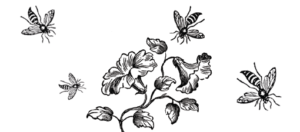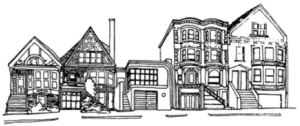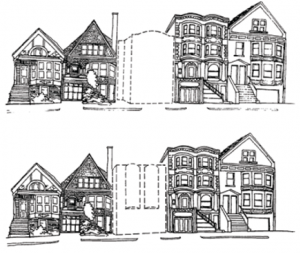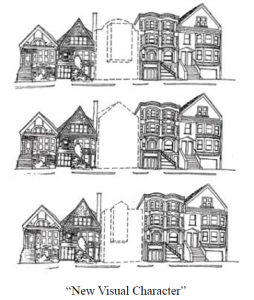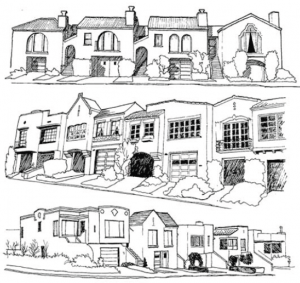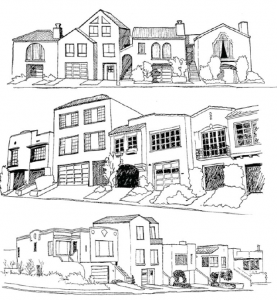News & Events
Miraloma Life: April 2012
- What is the MPIC Spring Fling?
- Arbor Day Petition Drive to Save Mt. Davidson Trees
- A Neighborhood Garden Treasure
- Teresita Boulevard Traffic Calming Plan Update
- Redistricting
- Ruth Asawa School of the Arts Performances
- Botanical Illustration Classes
- Summary of MPIC Board Meeting on March 1, 2011
- Longing
- Miraloma Park Residential Design Guidelines (MPRDG)
What is the MPIC Spring Fling?
by Shannon Chu
It’s a neighborhood all-ages bouncy-house play date that you don’t want to miss!
Join us rain or shine on Saturday, April 14, 3 to 6 pm at the Miraloma Park Improvement Club Clubhouse located at 350 O’Shaughnessy at Del Vale. Free Hot Dogs and Sausages will be served up by Gorilla Pete.
Chips and drinks will also be provided. Gardeners—bring your extra bulbs, cuttings, and potted plants for exchange and share your best landscaping tips for our special Miraloma Park climate. Everyone—learn more about MPIC activities and membership and share your ideas for future MPIC events. This is a great FREE opportunity to meet your neighbors and have some fun.
Arbor Day Petition Drive to Save Mt. Davidson Trees
by Jacquie Proctor
As the City completes the Final Environmental Impact Report (EIR) for the proposed Significant Natural Resource Areas Management Plan, a petition drive to advocate saving the trees on Mt. Davidson and other natural areas proposed for deforestation has been launched by a new coalition of park neighbors and associations called the San Francisco Forest Alliance (SFFA). The petition, available for signing at the SFFA website (http://signon.org/sign/stop-the-wasteful-destructio-1?source=s.em.mt&r_by=2436033), opposes the destruction of healthy non-native trees, the use of toxic herbicides, and the trail closures that would result if the City’s plan goes forward as proposed in the Draft EIR. The Natural Areas Program division of the San Francisco Recreation and Park Department controls one-fourth of the park area in the City. While recreation services are cut year after year, this program is granted an annual budget of $1.5 million or more to remove non-native vegetation, conduct spraying of Tier I and II herbicides, restrict public access, and plant native plant seedlings. Existing and proposed Park Bond funds designated for trail restoration or improvement are also being spent to implement these Natural Areas Program goals.
Addressing concerned citizens at public meetings, City staffers deny that existing or proposed Park Bond funds designated for trail restoration in the Natural Areas are being used to pursue the Significant Natural Areas Resource Plan, especially since the EIR for this plan has yet to be approved. However, the City is using this money to fund an aggressive evaluation of trees located within 50 to 100 feet of trails in the Natural Areas that is resulting in significant swathes of trees being cut down. This process is visible in Glen Canyon and the Mount Sutro Interior Greenbelt. The Project Status Report for the Park Bond funds also shows substantial sums set aside for habitat restoration—replacement of non- native plants with native species—as part of the trail closure/relocation projects. But the Report does not allocate any funds for replacement of trees cleared along the trails. Whether the $500,000 of bond money set aside for Mt. Davidson Park will be primarily used to clear away a substantial number of trees along the trails is yet to be seen. Public meetings on the project are planned for Fall, 2012.
Arbor Day was created in 1872 to encourage tree planting and care on at least one day a year. The Poet of the Sierras, Joaquin Miller, and former Mayor Adolph Sutro promoted the first celebration of Arbor Day in San Francisco with a tree planting ceremony in 1886 on what is now Yerba Buena Island. As his personal contribution to the event, Adolph Sutro gave 50,000 trees to be planted by school children of Oakland and San Francisco. These trees now comprise a major portion of San Francisco’s urban canopy, and each one in this historic forest absorbs 8 tons of carbon dioxide per year. The forest also provides habitat for wildlife and is a major stopping-off point for many migratory birds not seen elsewhere in San Francisco.
More information about the San Francisco Forest Alliance and the Natural Areas Program can be found at www.sfforest.net.
The San Francisco Forest Alliance plans to deliver the petitions to save the trees to Mayor Ed Lee to commemorate National Arbor Day on April 27, 2012.
A Neighborhood Garden Treasure
by Kathy Rawlins
In the early 1990s, the Board of the Miraloma Park Improvement Club (MPIC) started major renovations on the Clubhouse at 350 O’Shaughnessey Blvd. The interior required extensive lighting upgrades and new drapery. The exterior was repainted, and as we looked at the grounds, we decided they were also in need of sprucing up.
The parking lot is bordered by Del Vale and O’Shaughnessey Blvd. The grounds bordering on Del Vale had a nice patch of yellow flowering ground cover. To protect the grounds from cars driving into the lot over the plantings, a picket fence was installed along the perimeter. The grounds along O’Shaughnessey Blvd were very unsightly, with just dirt, gravel, and weeds. During discussions about this area, it became apparent that we needed a solution that would not only improve the look but also be low-maintenance and cost-effective.
In order to save money on watering and irrigation, Board members working on a solution thought of using a year-round spring that had been draining behind the Clubhouse perennially, and actually had made the Clubhouse tilt by softening of the ground beneath the foundation. If we could divert this spring to water the garden, it would both prevent further one-sided settling of the Clubhouse foundation and provide water at no cost. Funds were allocated to install a pipe to bring the stream to the garden area along O’Shaughnessy, where smaller feed lines would distribute the water. Since this was a native spring, and because native plant gardens require very little water and are low-cost once established, it seemed appropriate to focus on native plantings.
The MPIC President at the time was Dan Liberthson. He applied for a grant from the Mayor’s Office of Neighborhood Services to purchase plants and cover other costs of their installation. Labor was to be provided entirely by neighborhood volunteers, and by California Native Plant Society (CNPS) members, notably Jake Sigg. He not only helped with the planting and subsequent care but also provided us with the names of plants that were not only California Natives but also native specifically to Glen Park Canyon, across O’Shaughnessy Boulevard, or at least to the Mt. Davidson area. Based on this plan, the grant from the Mayor’s Office (then under Willie Brown) was awarded, and the amount of the grant was matched by the MPIC.
The MPIC held the first of many community planting events, beginning with installation of plants at the Del Vale end of the land. The plants were purchased from the Annual CNPS Fall sale in 1995. About twenty neighbors, including men, women and children, came to the Clubhouse to help with that first planting. The initial plants flourished so well that it was decided to continue the project all the way along the land between the paved parking lot and O’Shaughnessy. Every 2 to 3 years since 1995, the Club has invested in new native plants and neighbors have helped put them in the ground and do the necessary weeding. Today, this area has been nearly completely filled in with native plants, and is one of the premier stops on the CPNS annual tour of native plant gardens in San Francisco. Some plants, largely Ceanothus species, have also been placed along the west and north boundaries of the Clubhouse land.
In creating and nurturing this garden, the community has helped to preserve native plant species that support indigenous wild life, including birds, butterflies, moths, and other insects. The stinging nettle, one of our plantings, is a larval host plant for the strikingly beautiful red Admiral butterfly and food for the elusive Satyr Anglewing. If you visit the garden this Spring, you will see in blossom the purple and blue Douglas wild iris (Iris douglasiana), as well as the ornate Evergreen Currant (Ribes viburnifolium), with its cascading dark pink and white flowers. Bright orange California poppies (Eschscholzia californica); the lovely white lace flowers of the Cow Parsnip (Heracleum lanatum), orange Sticky Monkey (Mimulus aurantiacus) blossoms, and the blue blooms of the Ceanothus (also known as California lilac), are all richly present for your enjoyment. Later, in the summer and Fall, you will see more flowering plants in bloom along the edge of Del Vale. The wild strawberry (Fragaria californica) ground cover is filling in all areas under the Coyote (Baccharis pilularis) and L izard tail (Eriophyllum staechadifolium) bushes.
The upcoming Spring Fling community celebration (on April 14; see article in this issue) will be a great time to admire and enjoy the riches of our native plant garden. As you munch on a sausage or quaff the drink of your choice, while the kids cut loose in the bouncy house, take a few minutes to walk slowly along the edge of the garden and notice its bounty. We are sure you will agree that this unique and lasting neighborhood treasure, funded by the MPIC and the city of San Francisco to be a preserve for local native plants and created by the volunteer labor of enthusiastic Miraloma Park neighbors, is one of the crowning achievements of our community.
Teresita Boulevard Traffic Calming Plan Update
by Gary Noguera
Long-term Miraloma Park residents will remember the MPIC Board’s efforts to get the Municipal Transportation Agency (MTA) to address speeding on Teresita Boulevard. We started a formal process called Traffic Calming. At community meetings at the Clubhouse, the MTA received neighbors’ feedback and approved a plan in 2006 scheduled for completion in 2009. However, only the first of three phases of the project is complete, including the electronic speed sign at upper Marietta/Teresita, a speed hump, and revamping the Bella Vista intersection. Phases 2 and 3 remain unimplemented.
Phase 2 was to include three median islands at the Fowler “Y” and street-narrowing “choker islands” and “curb bulb-outs” all along Teresita to discourage speeding. A traffic circle at the “Y” was considered, but it is unclear whether this remains part of the plan. Phase 3 would include the installation of bulb-outs on lower Foerster to discourage speeding and blowing through the stop sign when turning right onto Teresita. (Note: If you’re tempted to run that stop sign, beware! We requested special police enforcement at that intersection.)
The MPIC Board is frustrated with the MTA’s delays, and has tried to get the project going again. We plan to invite the MTA to a community meeting at which they can explain the delays and take comments. A large turn-out at this meeting will be essential to get their attention. Residents near the Fowler “Y” should attend to reiterate their opposition to a traffic circle. Until this meeting is scheduled, please contact MTA Head Ed Reiskin (e-mail ed.reiskin@sfmta.com; phone 701-4720) to ask why the work has been delayed so long and insist that it be re-started. Also, contact MTA Board of Directors President Tom Nolan. Apparently he prefers to avoid those pesky citizens he serves, as his email and phone number are not listed in the city employee directory, but you can phone the MTA general business office at 701-4500 or email the entire MTA Board at mtaboard@sfmta.com. The MPIC will provide notice of the community meeting when a date is set. The complete Teresita plan is at www.sfmta. com/cms/ocalm/TeresitaBoulevard.htm.
Redistricting
by Robert Gee and Dan Liberthson
On March 7, the MPIC submitted the following letter to the Redistricting Task Force:
“The Miraloma Park Improvement Club (MPIC) is a registered non-profit Neighborhood organization representing 650 members and 2200 households currently contained wholly in the current District 7. The MPIC was formed in 1935 and has been representing the common interests of our neighborhood for the past 75 years. We are members of the West of Twin Peaks Central Council (WTPCC), to the monthly meetings of which we send a delegate to address issues of mutual concern.
The neighborhoods represented by the WTPCC, including Miraloma Park, were mostly built between 1912 and 1950 and are primarily composed of owner-occupied, single-family homes. Our residents choose to live here because it is a medium-density area that provides space for yards and children, as well as local commercial shopping districts and recreation options and parks. Cumulatively, we have a shared history of protecting and improving the shared characteristics and the character of our neighborhoods.
The MPIC shares the WTPCC’s concern, expressed in its letter of March 4, that our voting power may be diluted by moving seven WTPCC member organizations into adjoining districts, as proposed by Task Force Visualization 7. Therefore, we request that Miraloma Park remain in District 7 and we support the WTPCC’s suggested map for redistricting with respect to other neighborhoods.”
MPIC Director Karen Breslin gave public comment at the Task Force meeting held at West Portal Elementary on March 12. Karen Wood and Robert Gee also attended this meeting, along with at least 60 other community members, most of whom represented West of Twin Peaks neighborhood associations.
Ruth Asawa School of the Arts Performances
by Dan Liberthson
If you missed the smash hit run of The Producers at The Ruth Asawa School of the Arts last month, there are still plenty of opportunities to appreciate the incredible talent of our public arts high school students.
I was lucky enough to catch The Producers and was astonished at how accomplished a production it was. From the choreography, direction, and set design to the acting, vocals, and orchestra, everything was top-notch, as good as many professional companies I’ve seen. What a delight it was! And I was similarly impressed in January when I saw a program of short films created by the school’s media students. So much talent in kids not even out of high school!
April’s performance schedule will include visual art shows, an Opera Gala, theater productions, and even a big band performance at Yoshi’s. Based on the wonderful work I’ve seen so far, the reasonable admission prices, and the convenience of quality arts performances practically next door, you’ll want to make as many performances as you can. Come join the fun!
For a full listing of performances at Ruth Asawa SOTA, check out their website at www.sfsota.org.
Botanical Illustration Classes
The Mary L. Harden School of Botanical Art is offering art classes at the MPIC Clubhouse under the auspices of San Francisco Parks Alliance. These well-known classes offer the “first timer” with no art experience the opportunity to draw accurately from nature in a short time using pencil and pen and ink.
Those who want more can continue on through a stepped curriculum in watercolor leading to mastery, exhibitions, and a Certificate in Botanical Illustration. The schedule includes Colored Pencil Techniques for Botanical Illustration (April 9 to June 4), Advanced Watercolor Techniques in Botanical Illustration (April 10 to May 29; completion of beginner classes required), and a Master Class in Botanical Illustration (April 11 to May 30; completion of beginner classes required). For more information or to register please visit website http://sfnpc.org/botanicalillustration/
Summary of MPIC Board Meeting on March 1, 2011
by Dan Liberthson and Carl Schick
Treasurer’s Report (T Sauvain): In February, the MPIC’s net worth was $28,079, increased by $1001 from January; the total reserved for major repairs was $18,750. February rental activity slowed ($2117 vs $3162 in January), but signing a recurring twice-a-week renter at $100 per session helped keep our income strong. We will renew our recurring rental contracts with Grace Community Church, the Men’s Group, Staci Boden, and Mary Harden (art group). All required 2011 tax filings have been completed. February income comprised $270 in advertising fees. Over and above normal monthly expenses (Miraloma Life costs, utilities, etc.), we spent in February $45 for Coalition for SF Neighborhood dues, $650 for the iron work to install railings on the stairs to the Clubhouse stage, and $100 for a gift card for Pete Renteria for all of his help at the Clubhouse.
Committees: Zoning and Planning (ZAP, C Mettling-Davis [CMD])—A 311 notice (expiring March 29) was issued for 300 Cresta Vista. The work, which includes a large deck with an iron fence, appears to have been done outside the scope of the permit. The homeowners may need to resubmit the design plans. Membership (R Gee)—As of 2/28, the MPIC had 620 members. Eighty members whose memberships expired in December and January will receive a personalized reminder letter. Highlights in February included: 76 membership renewals, four new members, three members renewing at the $50 contributing level, and one with $100 contribution. Clubhouse Maintenance (C Mettling-Davis [CMD])—The front steps and railing of the Clubhouse have been repainted by the contractor located by CMD and look great. Railings for the stairs to the Clubhouse stage are ready to be installed. CMD will oversee the installation with the contractor.
Clubhouse Rental (T Sauvain)—Apparently, some rentals have been cancelled due to inability to find a reasonable insurance rate. T Sauvain indicated that we have insurance provider referrals for potential renters; renters who cannot get other insurance should be referred to him. Events (S Chu)—The official date for the MPIC Spring Fling will be Saturday, April 14 from 3 to 6 pm. Free food and drinks will be provided. The ever-popular bouncy house will be available for kids of all ages to play in. Additionally, we will have a plant exchange at which people can bring potted plants, bulbs and cuttings to trade for another plant of their choice. S Chu moved that up to $1200 be allocated to cover expenses for the Spring Fling (motion passed).
Delegate Reports: West of Twin Peaks Central Council (WTPCC, K Breslin)—There will be a redistricting meeting concerning District 7 on March 12th. MPIC will submit a letter requesting that Miraloma Park remain in District 7. For future task force meeting dates, go to sfgov.org/rdtf. The Council also passed a motion to draft a ballot argument for the upcoming Coit Tower ballot initiative. Coalition for SF Neighborhoods (K Rawlins for D Liberthson)—There is a push to shift more power over land use to the Zoning Administrator. Save the Forest—Please see article in this issue.
Old Business: R Gee moved that the Board set aside $18,500 in a reserve account for major Clubhouse repairs, with $2600 to be added each year. The repairs would need to be approved by MPIC board members.
New Business: Jacquie Proctor led a walking tour of Mt. Davidson on 2/25 to point out which areas will be subject to tree cutting and removal, based on a plan by the Natural Areas Program (NAP). The SF Forest Alliance is fighting that plan and has created an online petition for all interested SF residents to sign at www.sfforestalliance.net. Members of the Alliance are also soliciting signatures in person. K Wood is drafting an introductory memo to accompany the petition, specifying that Mt. Davidson and Sutro Heights will be affected. The memo will be presented when the petition is circulated in Miraloma Park.
Longing
Dream
lovely dream
full of life’s delight
as a red sail bellied by the night
where have you gone
round spinnaker that sped me on?
Shredded by the hard wind
that woke with the dawn?
by Dan Liberthson
Miraloma Park Residential Design Guidelines (MPRDG)
To make Miraloma Park home-owners more aware of our MPRDG, we plan to reprint most of the document in the Miraloma Life as space permits. The complete MPRDG appear at www.miralomapark.org. They were adopted into the San Francisco Planning Code in 1999. The MPRDG text below continues from the excerpt in the December 2011 issue of Miraloma Life, which described “Clearly Defined Visual Character” and “Complex Visual Character.”
Section 2, Neighborhood Character, Continued
• Undefined Visual Character
“In many blockfaces, an overriding visual character may not be apparent, or the character may be mixed or changing.
When no clear pattern or style is evident on a blockface, a designer has both greater flexibility in design and a greater opportunity (as well as responsibility) to help define, unify, and contribute positively to the existing visual context. Existing incompatible or poorly designed buildings in the project’s area, however, do not free the project sponsor from the obligation to enhance the area through sensitive development.
The following five examples show the great flexibility of design solutions when the neighborhood character is undefined. Each response, however, is derived from existing visual patterns and each attempts to unify the block face.”
• “New Visual Character”
“When the existing visual character offers little interest, new construction or extensive remodeling should seek to improve the context. When a row of new residential buildings or a single building on a wide lot is proposed on a block where the existing housing has poor visual character, a unique opportunity to define a more desirable future visual character of the area is presented. The new building or buildings then become the context with which later construction must be compatible. In these cases the facades of individual buildings or vertical facade dimensions in the case of a very wide building should not be either uniform or entirely different from each other.”
NEIGHBORHOOD CHARACTER OF MIRALOMA PARK
Miraloma Park was a planned community designed to have a mixture of architectural styles for variety and interest, but with common elements that form a strong visual pattern and a coherent sense of character. Often, there will be two or (at most) three different styles on one block face, but a unifying rhythm is still maintained. Thus, Miraloma Park can be considered a complex situation, as described on page 11, in which “building forms and structures are varied, yet the row still ‘works.’ The following rows adapted from Miraloma Park streets illustrate this “complex situation.”
When existing patterns and rhythms are ignored, the visual character will be damaged, as shown in the examples below.


